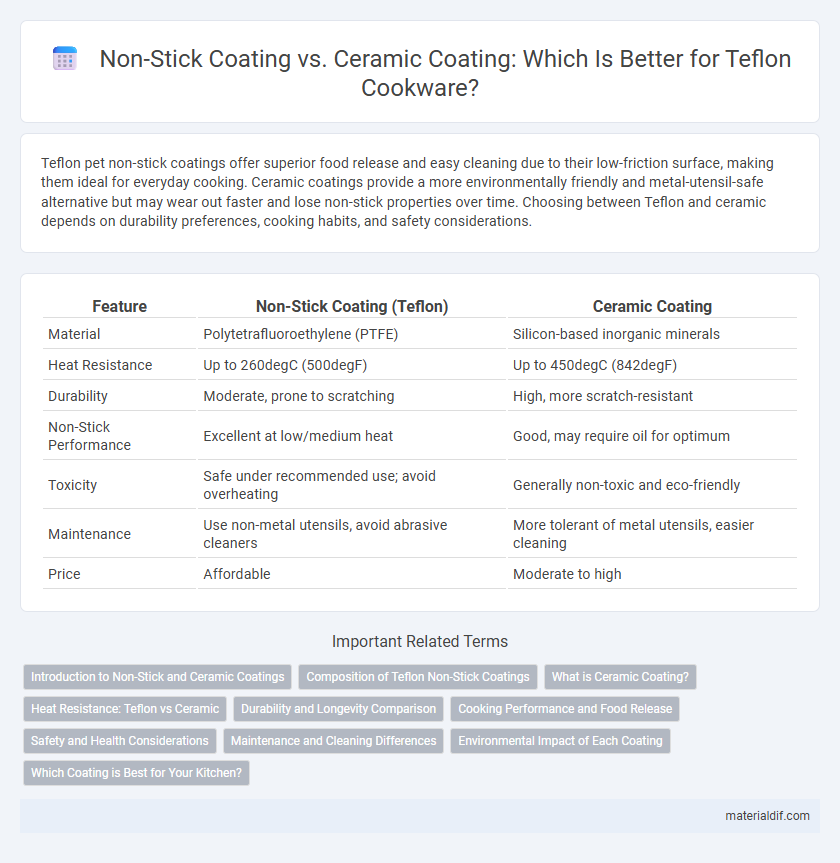Teflon pet non-stick coatings offer superior food release and easy cleaning due to their low-friction surface, making them ideal for everyday cooking. Ceramic coatings provide a more environmentally friendly and metal-utensil-safe alternative but may wear out faster and lose non-stick properties over time. Choosing between Teflon and ceramic depends on durability preferences, cooking habits, and safety considerations.
Table of Comparison
| Feature | Non-Stick Coating (Teflon) | Ceramic Coating |
|---|---|---|
| Material | Polytetrafluoroethylene (PTFE) | Silicon-based inorganic minerals |
| Heat Resistance | Up to 260degC (500degF) | Up to 450degC (842degF) |
| Durability | Moderate, prone to scratching | High, more scratch-resistant |
| Non-Stick Performance | Excellent at low/medium heat | Good, may require oil for optimum |
| Toxicity | Safe under recommended use; avoid overheating | Generally non-toxic and eco-friendly |
| Maintenance | Use non-metal utensils, avoid abrasive cleaners | More tolerant of metal utensils, easier cleaning |
| Price | Affordable | Moderate to high |
Introduction to Non-Stick and Ceramic Coatings
Non-stick coatings like Teflon are primarily made from polytetrafluoroethylene (PTFE), offering excellent food release and easy cleanup due to their low friction surface. Ceramic coatings consist of inorganic minerals derived from sand and provide a non-reactive, durable, and metal utensil-safe cooking surface that is typically free of PTFE and PFOA. Both coatings improve cooking performance, but ceramic coatings emphasize eco-friendliness and higher heat resistance, while Teflon focuses on superior non-stick properties.
Composition of Teflon Non-Stick Coatings
Teflon non-stick coatings primarily consist of polytetrafluoroethylene (PTFE), a synthetic fluoropolymer known for its high chemical resistance and low friction properties. Unlike ceramic coatings, which are typically composed of inorganic minerals such as silicon and oxygen compounds, Teflon's unique molecular structure creates a smooth, durable surface that prevents food from adhering. The PTFE chains in Teflon coatings provide superior non-stick performance and thermal stability up to 260degC, distinguishing it from ceramic options that can be less flexible and more prone to chipping.
What is Ceramic Coating?
Ceramic coating is a non-stick surface made from inorganic materials like silica, derived from sand, designed to offer a durable and heat-resistant alternative to traditional Teflon coatings. Unlike Teflon, ceramic coatings provide a chemical-free, scratch-resistant finish that can withstand higher cooking temperatures without releasing toxic fumes. This type of coating enhances cookware longevity while promoting healthier cooking through its natural non-stick properties.
Heat Resistance: Teflon vs Ceramic
Teflon non-stick coatings typically withstand temperatures up to 500degF (260degC) before degrading, whereas ceramic coatings offer superior heat resistance, often tolerating temperatures as high as 800degF (427degC). This makes ceramic coatings more suitable for high-heat cooking methods such as searing and stir-frying. The enhanced thermal stability of ceramic coatings reduces the risk of toxic fumes and deterioration compared to Teflon at elevated temperatures.
Durability and Longevity Comparison
Teflon non-stick coatings typically offer excellent release properties but tend to degrade faster under high heat, limiting their longevity compared to ceramic coatings. Ceramic coatings provide superior durability due to their inorganic composition, resisting scratches and high temperatures better, which extends the cookware's lifespan. While Teflon may require replacement within a few years, high-quality ceramic coatings can maintain their non-stick performance for significantly longer periods with proper care.
Cooking Performance and Food Release
Teflon non-stick coatings provide superior cooking performance by allowing food to release effortlessly even at high temperatures, reducing the need for excessive oil or butter. Ceramic coatings offer a natural, chemical-free surface that performs well for moderate heat cooking but may lose non-stick properties faster under intense use. Both coatings enhance food release, but Teflon remains the preferred choice for consistent, reliable non-stick performance in professional and home kitchens.
Safety and Health Considerations
Teflon non-stick coatings, made from polytetrafluoroethylene (PTFE), are generally safe under normal cooking temperatures but can release harmful fumes when overheated above 500degF (260degC), posing respiratory risks. Ceramic coatings, typically free from PTFE and PFOA, offer a non-toxic alternative with higher heat tolerance and lower chances of chemical leaching, making them safer for health-conscious users. Both coatings require proper use and care to maintain safety, as excessive heat or damage can compromise their protective properties.
Maintenance and Cleaning Differences
Teflon non-stick coatings require gentle cleaning with soft sponges to maintain their smooth surface and prevent scratching, avoiding abrasive pads and harsh detergents. Ceramic coatings offer greater durability against high temperatures and chemical abrasion but may accumulate residue more quickly, needing regular cleaning with mild soap and water to prevent staining. Both coatings benefit from hand washing and avoiding dishwasher use to prolong their lifespan and effectiveness.
Environmental Impact of Each Coating
Teflon non-stick coatings primarily consist of polytetrafluoroethylene (PTFE), which can release harmful fumes when overheated, posing risks to both human health and the environment. Ceramic coatings are typically made from inorganic materials like silica and emit fewer volatile organic compounds (VOCs) during manufacturing and use, resulting in a lower overall environmental footprint. However, ceramic coatings tend to have a shorter lifespan, potentially leading to more frequent replacements and increased resource consumption over time.
Which Coating is Best for Your Kitchen?
Teflon non-stick coatings offer superior food release and easy cleaning, making them ideal for low- to medium-heat cooking, while ceramic coatings provide a chemical-free, high-heat resistant option with enhanced durability and scratch resistance. Choosing the best coating for your kitchen depends on your cooking style: Teflon excels in frying and sauteing with minimal oil, whereas ceramic suits high-temperature cooking and those seeking eco-friendly materials. Both coatings improve cookware performance, but Teflon's proven track record and affordable prices make it a popular choice for everyday use.
non-stick coating vs ceramic coating Infographic

 materialdif.com
materialdif.com